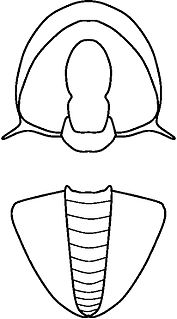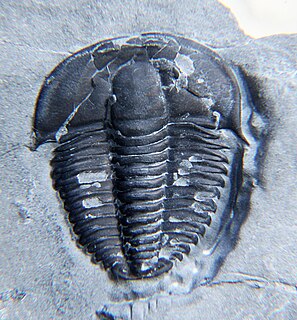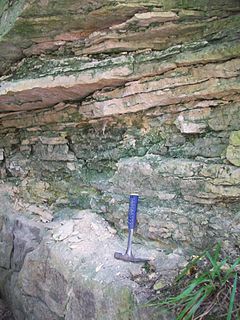Related Research Articles
The Cambrian Period was the first geological period of the Paleozoic Era, and of the Phanerozoic Eon. The Cambrian lasted 55.6 million years from the end of the preceding Ediacaran Period 541 million years ago (mya) to the beginning of the Ordovician Period 485.4 mya. Its subdivisions, and its base, are somewhat in flux. The period was established by Adam Sedgwick, who named it after Cambria, the Latin name of Wales, where Britain's Cambrian rocks are best exposed. The Cambrian is unique in its unusually high proportion of lagerstätte sedimentary deposits, sites of exceptional preservation where "soft" parts of organisms are preserved as well as their more resistant shells. As a result, our understanding of the Cambrian biology surpasses that of some later periods.
The Ordovician is a geologic period and system, the second of six periods of the Paleozoic Era. The Ordovician spans 41.6 million years from the end of the Cambrian Period 485.4 million years ago (Mya) to the start of the Silurian Period 443.8 Mya.
The Silurian is a geologic period and system spanning 24.6 million years from the end of the Ordovician Period, at 443.8 million years ago (Mya), to the beginning of the Devonian Period, 419.2 Mya. The Silurian is the shortest period of the Paleozoic Era. As with other geologic periods, the rock beds that define the period's start and end are well identified, but the exact dates are uncertain by a few million years. The base of the Silurian is set at a series of major Ordovician–Silurian extinction events when up to 60% of marine genera were wiped out.

Plectronocerida is a primitive order from which subsequent cephalopod orders are ultimately derived.
The Ellesmerocerida is an order of primitive cephalopods belonging to the subclass Nautiloidea with a widespread distribution that lived during the Late Cambrian and Ordovician.

Acidiscus Rasetti, 1966, is a genus of Eodiscinid trilobite belonging to the family Weymouthiidae Kobayashi T. (1943), Order Agnostida Salter (1864). It lived during the Botomian stage = late Lower Cambrian Stage 4 ; the upper Botomian boundary corresponds to base of the Middle Cambrian, Miaolingian Series and Wuliuan stage.
Clarkoceras is a genus of breviconic ellesmerocerid cephalopods, one of only two genera known to have crossed from the Late Cambrian, Trempealeauan, into the Early Ordovician, Gasconadian. ; the other being Ectenolites.
The Gasconadian Stage is the first stage of the Ordovician geologic period in North America and of the Lower Ordovician Canadian Epoch, coming immediately after the Late Cambrian Trempealeauan and preceding the middle Canadian Demingian Stage. The Gasconadian is equivalent to the European Tremadocian and roughly to the Skullrockian of the Ibexian series.
The Dresbachian is a Maentwrogian regional stage of North America, lasting from 501 to 497 million years ago. It is part of the Upper Cambrian and is defined by four trilobite zones. It overlaps with the ICS-stages Guzhangian, Paibian and the lowest Jiangshanian.
The Franconian is the middle stage of the Upper or Late Cambrian in North America, equivalent to the Chinese Changshanian with a span of nearly 4.5 million years, from about 497 to 492.5 Ma. The name comes from the Franconia Formation, about 100 feet of sandstone and green shale exposed near the town of Franconia in eastern Minnesota, north of St Paul.
The Cassinian is the latest age of the Canadian Epoch when thought of temporally and the uppermost stage of the Canadian Series when thought of stratigraphically. The Canadian, either as a series or as an Epoch is the name that has been given to the Lower, or Early, Ordovician in North America and has been applied worldwide.
Jiagouceras is a genus of early primitive cephalopods from the Upper Cambrian of China, assigned to the Plectronoceratidae. The shell is small, nearly straight with a slight endogastric curvature and compressed cross section. The siphuncle is close to the ventral margin, with segments expanded into the chambers.
Paraplectronoceras is a genus of very early nautiloids from the middle Late Cambrian, named by Chen and Qi, 1979, type species Paraplectronoceras pyriforme, for small, endogastrically curved forms found in the upper Yenchou and Wanwankou members of the Fengshan Formation of northeastern China.
Cambrian Stage 4 is the still unnamed fourth stage of the Cambrian and the upper stage of Cambrian Series 2. It follows Cambrian Stage 3 and lies below the Wuliuan. The lower boundary has not been formally defined by the International Commission on Stratigraphy. One proposal is the first appearance of two trilobite genera, Olenellus or Redlichia. Another proposal is the first appearance of the trilobite species Arthricocephalus chauveaui. Both proposals will set the lower boundary close to 514 million years ago. The upper boundary corresponds to the beginning of the Wuliuan.
Acaroceratidae is family of Upper Cambrian (Trempealeauan) nautiloid cephalopods included in the Ellesmerocerida that contains two known genera, Acaroceras and Weishanuceras, both found in northern China.

Kendallina is a genus of trilobite with an inverted egg-shaped outline, a wide headshield, small eyes, small deflected spines, 12 thorax segments and a small, short tailshield. It lived during the Upper Cambrian in what are today Canada and the United States.

The Jordan Formation is a siliciclastic sedimentary rock unit identified in Illinois, Michigan, Wisconsin, Minnesota, and Iowa. Named for distinctive outcrops in the Minnesota River Valley near the town of Jordan, it extends throughout the Iowa Shelf and eastward over the Wisconsin Arch and Lincoln anticline into the Michigan Basin.
The Trempealeau Formation is an Upper Cambrian geologic formation in Wisconsin. It contains graptolites.
Christina Lochman-Balk was an American geologist who specialized in the study of Paleozoic era fossils, formerly known as Cambrian Paleontology. Lochman specifically dealt with Cambrian trilobites and invertebrates. During her career, it was not very common for women to pursue degrees or careers in geology, which was studied mostly by men. Along with her research, she also served as a lecturer and professor at the universities Mount Holyoke, University of Chicago and the New Mexico Institute of Mining and Technology. She received two degrees from Smith College in Northampton, Massachusetts in Geology, and her doctorate at Johns Hopkins University in 1933. She married Robert Balk in 1947, who was a geology professor at the University of Chicago. Following her husband's death in 1955, she became a full professor as well as appointed head of the geology department of the New Mexico Institute of Mining and Technology in 1957. She retired from her position in 1972.

The Bliss Formation is a geologic formation that is exposed in southern New Mexico, west Texas, and southeastern Arizona. It preserves fossils dating back to the late Cambrian to early Ordovician periods.
References
- Chen Jun-yuan & Teichert C, 1983; Cambrian Cephalopods, Geology Vol 11, pp647–650, Nov 1983
- Flower R.H.1964, The Nautiloid Order Ellesmerocerida (Cephalopoda) Menoir 12, New Mexico Bureau of Mines and Mineral Resources, Socorro, NM
- Harland,W. B. et al1 990. A Geologic Time Scale 1989. Cambridge University Press, Cambridge . Ref in Paleobiology Database on line.
- Moore, Lalicker, and Fischer 1952; Invertebrate Fossils; McGraw-Hill; fig 1-17.
- Geowhen database.
| This geochronology article is a stub. You can help Wikipedia by expanding it. |